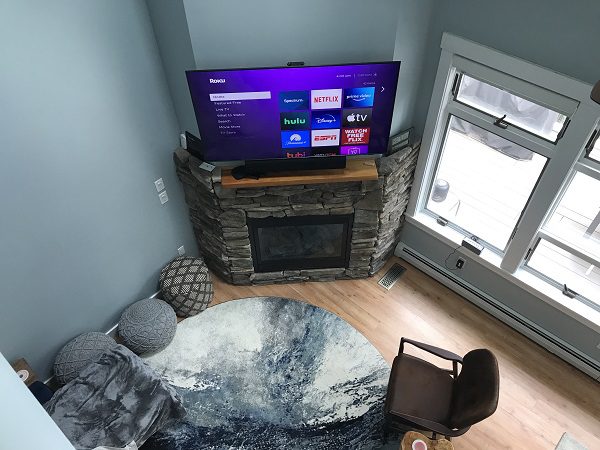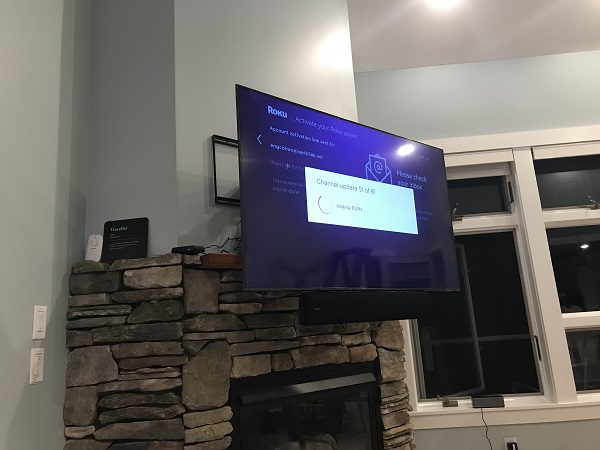Look at a Google search, and you will see how popular it is for people to mount their TV over a fireplace. As a professional installer, you’ve likely heard all the reasons why it might be a mistake to do that, however. The heat will damage the TV. The viewing angle is too high. The TV will be off axis. The list goes on.
But is it really that bad of an idea to mount a TV above a fireplace?
Is Mounting Your TV Above the Fireplace a Good Idea?
The short answer is yes. Once upon a time, it was a bad idea to hang your TV over your fireplace, but now, with the right tools and equipment, that couldn’t be further from the truth. Of course, that doesn’t mean it’s going to be a walk in the park like it is to hang a TV on some drywall and studs.
Can the TV Still be Damaged by Heat?
Absolutely. You still need to make sure that your TV isn’t damaged by the heat, in addition to making sure the TV will also be at a comfortable viewing height for the audience. Done right, however, you can mount a TV over a fireplace in a way that’s cost-effective, efficient and, most importantly, safe.
Why Mount Your TV Over the Fireplace?
For many homeowners, a fireplace is the most logical spot to mount a TV. After all, it’s the main focal point of the room, with many living spaces designed such that sofas face the fireplace at the center so family members and guests can gather around it in the evening and enjoy the relaxing ambience with a movie or show.
It might also be the only reasonable option available in homes that sport open concept floorplans or an abundance of windows. Aside from that, there’s no debating the aesthetics a TV mounted over a fireplace provides.
How Safe is it to Mount a TV on a Brick Fireplace vs. Wooden Studs?
Normally, a TV wall mount is affixed to studs behind drywall, providing a firm support. With a fireplace, there are no studs behind the wall to affix the anchors for the mount to. Instead you’re trying to affix the mount to stone, mortar or brick.
Despite these materials being a lot harder than wood, they don’t provide as much grip, with mortar being exceptionally weak for mounting with traditional anchors. While being glue for bricks, mortar is not glue for your TV. For this, mounting directly into brick and mortar is one of the few times where we will say you might want to reconsider, as it is generally viewed as a very weak mounting material, and can be further damaged by TV weight and excessive heating and cooling from the fireplace.
Outside of that, one of the biggest risks of mounting a TV over the fireplace is you penetrate the smoke chamber with your anchor, which would ultimately cause carbon monoxide and smoke to leak into the living space while the fire is in use. Aside from being incredibly dangerous, it’s also an incredibly expensive issue to fix.
How Much Clearance Does the TV Need Above the Fireplace?
Understanding the clearance of a fireplace is something you want to be aware of when determining how high to mount a TV over the fireplace. Clearance is a fancy way of saying the minimum distance from a fireplace that combustibles such as a mantel, shelf or flat-screen TV can be placed.

Wood fireplaces will throw off the most amount of heat while gas and electricity will produce far less. That said, the other, lower heat options are still capable of damaging a TV if it isn’t spaced properly.
However, if the fireplace already has a mantel in place, then you already know the fireplace’s clearance. In fact, if the TV is above the mantel, the mantel will act as a shield from the rising heat. Otherwise, you can look for a TV that comes with its own type of heat shield. Some TV mounts–like those from MantelMount–also come with heat alerts to notify of potential dangers.
How High Should the TV be Mounted for Comfortable Viewing?
The problem that enters the picture when mounting the TV over the mantel is that this often puts the viewing height for the TV well above eye level, requiring the viewer to crane their neck to see the television.
According to the Prairie Spine Institute, “If the TV is…mounted too high, people tend to look up. This could potentially lead to muscular imbalances, and stiffness, particularly of the neck.”

However, this issue is very easily remedied by being very specific with what type of mount you select for the project. Pull-down and full-motion mounts offer a variety of capabilities that enhance the TV-viewing experience.
The key words here are “full motion.” While tilt and swivel mounts are useful, it is the vertical movement in a dropdown mount that can bring the TV down to eye level when in viewing mode before popping back up above the fireplace when finished. No neck craning, no health problems, no doctor’s appointments. But how high should a mounted TV be when dropping down from its resting position?
“The good rule of thumb for the viewing distance with a fireplace or in any other situation is to take the size of your TV and divide by 0.55,” says Lee Marc of MantelMount.
“So a 55-inch TV would mean that the viewer should be about 100 inches, or eight feet, away from the screen.” (Marc goes into this in more detail when talking about the ideal height and viewing distance for a mounted TV).
How Should You Angle the TV for Best Picture Quality?
The best picture quality is going to come from watching your TV at eye level. If the viewer is not looking straight at the screen (as they likely would with a TV mounted above a fireplace), the result can be a washed-out image, as the viewer is only seeing a fraction of the light being produced by the TV.
Using a modern, full-motion TV wall mount over the fireplace helps address any issues easily. Mounts with vertical capability allow the viewer to bring the TV down to eye level. Since they are now looking straight at the screen, the problem of washed-out picture quality is eliminated.

Even for mounts without vertical movement—like tilt or swivel—they can at least be tilted downward to minimize loss of resolution.
Mounting TV Over the Fireplace Isn’t the Mistake it Once Was
A proper TV mounted over the fireplace will consider the size of the TV in conjunction with the optimal seating distance, have clean cable management, and a companion soundbar or other audio speakers.
Done right, it’s an aesthetic work of art that can provide comfort and entertainment for as long as a family lives in the home. It does require plenty of consideration, however, to make it work.

Jason Knott
A high a high-quality, full-motion mount can help eliminate issues with viewing angle and height while still protecting the TV from any potential damage, but what equipment/approach you take will ultimately depend on several factors such as fireplace type, wall material and more.
Now, armed with this information, the next time you have a customer who is considering mounting their TV above their fireplace but is concerned by articles stating it’s a bad idea, you will be able to explain that it is a fine idea and can help them achieve the perfect viewing experience while maintaining a clean aesthetic for the home.
You can tell them that putting their TV above their fireplace is a fine idea, and you know just the way they can do it.
Spencer Greenwald is the chief revenue officer at MantelMount.






